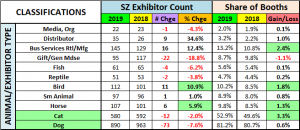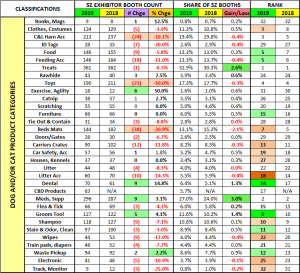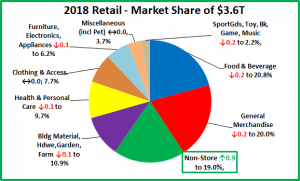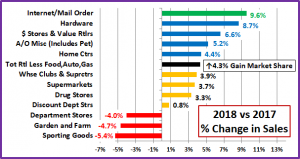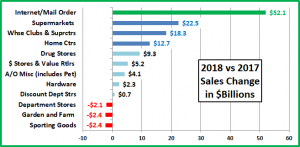Attending SuperZoo 2019? – It is a great Opportunity! But….You Need a Plan!
The WPA moved the show back to the traditional late summer timing. Now, it is 5 months after GPE which helps “feed” the New Product Showcase with more entries. The exhibitor count is down slightly but the booths continue to get bigger. To help attendees in working this huge show the floor sections were expanded and 2 new sections were created – International and the Poultry Zone. One thing is unchanged. There is a huge array of exhibitors in every product category.
Consider these 2019 SuperZoo facts:
- 1100+ exhibitors
- 7 Floor Sections: Natural, Rodeo Drive, Groomers, Critter Alley, 1st Time Exhibitors, International, Poultry Zone
- 269,000+ sq ft of exhibitor booths Plus, 30,000 sq ft to highlight: New Products, Made in USA and the Pet Tech Ctr.
- Over 20,000 attendees with more than 10,000 buyers.
- SuperZoo University: Seminars on Retail, Grooming and Animal Health – 110 hours; 82 separate sessions/topics
- Almost 5 miles of aisles – just to walk the exhibit floor
Whew! This show is huge. The show floor is open for 22 hours so…
Let’s “Do the Math!”
If you don’t attend any seminars, visit the New Product Showcase, stop to chat with anyone in the aisles or for food, a drink or to go to the bathroom and maintain a walking speed of 2.5 mph…
You can spend…1 MINUTE AND 5 SECONDS…with each exhibitor…
You definitely need a plan!
With a higher concentration of Pet retailer attendees and a commitment to groomers, there are subtle differences between SuperZoo and GPE. However, like GPE, SuperZoo has attendees from every major retail channel and attracts both exhibitors and attendees from around the globe.
Despite the variety of offerings to fill an attendee’s time, SuperZoo is still primarily about Pet Products. New Products are critical to maintaining and growing any business so you must take the time to visit the new product area. Knowledge is power so you should also sign up for any relevant classes. Sometimes it’s not what you know, but who you know that matters most. This makes networking with other industry professionals a priority.
Every business can improve in terms of products. If you are a retailer, what sections of your store are not doing as well as you hoped and need a “facelift” or conversely, what areas are growing and need products to fill additional space? Category managers for distributors and retail chains may only be interested in targeted visits to exhibitors relevant to their “categories”. Representatives may be looking for new manufacturers…in specific product categories. Manufacturers could be looking to find distributors to handle their products or just looking to “check out” the competition. In regard to products, there is always something to see…for everyone! Plus, there are 466 Exhibitors at SZ 19 that weren’t at GPE 19.
SuperZoo is a great place to review products but Business Services, everything from Private label to POS, have also become increasingly important. In fact, 1 out of every 8 exhibitors offers some type of Business Service. Attendees can now “Leave no stone unturned” in their quest for business success. SuperZoo is about gathering information and making decisions to improve your business – whether they are made on the spot or put on your “must do” list. Your only real limitation is time. How do you make the most effective use of your time on the show floor? Here’s a suggestion.
Use the Super Search Exhibitor Visit Planner to make SuperZoo easier and more productive. I initially designed it in 2014 and have updated the data and produced a new version for every GPE and SuperZoo since then…including SZ 2019.
The “update” is not just exhibitor lists but also to the product category offerings for every exhibitor. I reviewed every exhibitor profile on the show site, but I also visited over 1000 websites and conducted separate internet searches to “validate” their product offerings. It is not 100% accurate, but it is close.
What does the Super Search do?…It searches for and produces a list of Exhibitors by product categories.
- From the simplest – “give me a list that I can look at on my phone or tablet in either Booth # order or alphabetically”
- To the most complex…”can do a simultaneous search for multiple specific product categories, allowing you to personally narrow down the initial results and see the “final” alphabetically or by booth number.”
The SuperZoo Super Search Exhibitor Visit Planner does both…and more…and does it quickly! Take a look at the New Quick Start Guide. You will see that it looks complex but is really quite simple.
SUPERZOO 2019 Super Search Exhibitor Visit Planner – Quick Start Guide
The SuperZoo Super Search Exhibitor visit planner is designed to make your time on the show floor more efficient and more productive. With the Super Search you can conduct up to 5 separate and distinct product category searches simultaneously with consolidated results produced in booth # order to facilitate your “journey”. There are detailed instructions for reference and to help you understand the nuances of the tool. However, it is really very simple so let’s get started.
Here is the Dashboard where you set up your searches. ↓
On the dashboard, the first things to note are the numerous category columns. There are 7 different floor sections (International & Poultry Zone are new.), 11 different Exhibitor or Animal Types and 33 Dog and/or Cat Product categories. (CBD Products was added this year.) You can search exhibitors for any combination of these.
Let’s take a specific example running 3 simultaneous searches for several Dog/Cat categories:
- Toys
- Treats
- Catnip & Litter (Must sell both)
Now referring to the Dashboard, let’s take it by the numbers:
#1 – This column is where you activate each search. Type in a “Y” (Cells C3>C7 will auto-capitalize) This search “line” becomes active.(cell turns green) In our example we are running 3 searches so we have 3 “Y”s.
#2 – Now we enter a 1 in the correct column for each search line. Search Line 1: Toys; Search Line 2: Treats.
#3 – In Search Line 3 we want exhibitors that sell both Catnip and Litter so we put a 1 in both of these columns.
#4 – Now we just “click” the Execute Search Button. The searches are done simultaneously and the results combined into a single list in alphabetical order.
#5 – If you would like to view the list in Booth # order, just click the Booth # Sort.
#6 – You can switch the list back to an alpha view by clicking the Alpha Sort Button.
#7 – To Clear all your search categories and start a new search, click the Clear Criteria Button. Then click Execute (#4) again and you will be back to the full list
Note: Any Search Line with a Y and no 1’s in any column will always deliver the entire list regardless of what is selected in other lines. Change the Y back to an N in unused search lines. Now a sample of the results:
Company A – Has Toys Only; Company B has Dog Treats Only and is also a 1st Time Exhibitor at SuperZoo; Company C is on the list for Treats and also has Catnip, but no Litter. This is not unusual as Catnip is often a Treat; Company D has Treats & Toys. Company E has both Catnip and Litter and in fact, actually has it all!
Note: The Super Search highlights your search categories so you know “why you are there”. However, it also shows all categories that are available. Some might “pique” your interest while you are visiting the booth.
You can review the exhibitors alphabetically then put the list in Booth # order to make it easier to “work”. The Super Search also allows you to “cut down” the list during your review. (Pg 2; Point #11 – “U Pick ‘em” in Detailed Instructions) But First, I suggest that you “play” with the Super Search to get a “feel” for the tool, and then review the Detailed
Instructions. With your “play” experience, the detailed instructions will become a “quick read” and a valuable reference. You’ll soon be “up to speed” on the full capabilities of Super Search.
Good Luck and Good “Hunting” at SuperZoo 2019.
Ready to Start Planning?
Use the links below to download The Super Search (Be Sure to Enable editing/macros/content), the Quick Start Guide and the Detailed Instructions. Then GET STARTED!
(To save the PDF to your computer Right Click the download link and select “Save Link As…”)
(To save the PDF to your computer Right Click the download link and select “Save Link As…”)
(For the Excel file to work on your computer, be sure to enable macros/editing/content if asked.)
The Super Search has been updated to reflect exhibitors as of 8/16/19. The changes from 8/12 are highlighted in yellow. The changes from 8/5 to 8/12 are still highlighted in blue. The changes from 7/29 to 8/5 are still highlighted in pink. This is the “final” update before the show. Always look for the date in the file name to insure that you are using the most up to date edition of the planning tool.b






